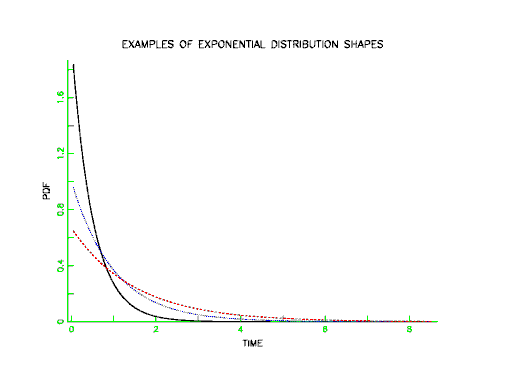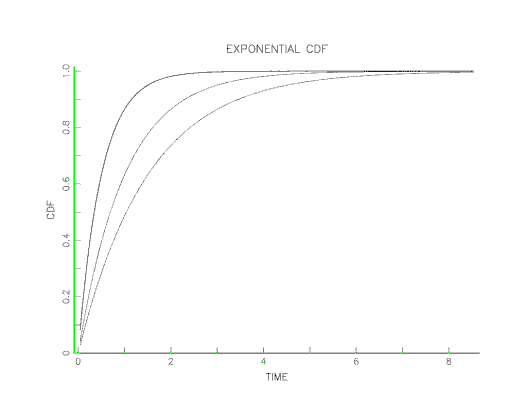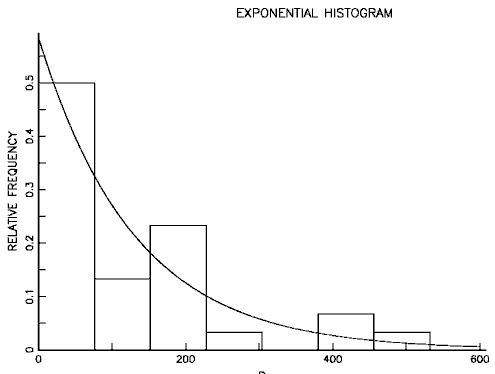from http://www.itl.nist.gov/div898/handbook/apr/section1/apr161.htm

8. Assessing Product Reliability
8.1. Introduction
8.1.6. What are the basic lifetime distribution models used for non-repairable populations?
|
| |
| All the key formulas for using the exponential model | Formulas and Plots The exponential model, with only one unknown parameter, is the simplest of all life distribution models. The key equations for the exponential are shown below: 
Note that the failure rate reduces to the constant  for any time. The exponential distribution is the only distribution to have a constant failure rate. Also, another name for the exponential mean is the Mean Time To Fail or MTTF and we have MTTF = 1/ for any time. The exponential distribution is the only distribution to have a constant failure rate. Also, another name for the exponential mean is the Mean Time To Fail or MTTF and we have MTTF = 1/ . . The Cum Hazard function for the exponential is just the integral of the failure rate or H(t) = t. t. The PDF for the exponential has the familiar shape shown below. |
| The Exponential distribution 'shape' |  |
| The Exponential CDF |  Below is an example of typical exponential lifetime data displayed in Histogram form with corresponding exponential PDF drawn through the histogram. |
| Histogram of Exponential Data |  |
| The Exponential models the flat portion of the "bathtub" curve - where most systems spend most of their 'lives' | Uses of the Exponential Distribution Model - Because of its constant failure rate property, the exponential distribution is an excellent model for the long flat "intrinsic failure" portion of the Bathtub Curve. Since most components and systems spend most of their lifetimes in this portion of the Bathtub Curve, this justifies frequent use of the exponential distribution (when early failures or wear out is not a concern).
- Just as it is often useful to approximate a curve by piecewise straight line segments, we can approximate any failure rate curve by week-by-week or month-by-month constant rates that are the average of the actual changing rate during the respective time durations. That way we can approximate any model by piecewise exponential distribution segments patched together.
- Some natural phenomena have a constant failure rate (or occurrence rate) property; for example, the arrival rate of cosmic ray alpha particles or Geiger counter tics. The exponential model works well for inter arrival times (while the Poisson distribution describes the total number of events in a given period). When these events trigger failures, the exponential life distribution model will naturally apply.
|
| Dataplot and EXCEL functions for the Exponential model | DATAPLOT and EXCEL Functions for the Exponential The Dataplot commands EXPPDF and EXPCDF calculate the exponential PDF and CDF for the standardized case with  = 1. To evaluate the PDF and CDF at 100 hours for an exponential with = 1. To evaluate the PDF and CDF at 100 hours for an exponential with = .01, the commands would be = .01, the commands would be LET A = EXPPDF(100,0,0.01)
LET B = EXPCDF(100,0,0.01) and the response would be .003679 for the pdf and .63212 for the cdf. Dataplot can do a probability plot of exponential data, normalized so that a perfect exponential fit is a diagonal line with slope 1. The following commands generate 100 random exponential observations ( = .01) and generate the probability plot that follows. = .01) and generate the probability plot that follows. LET Y = EXPONENTIAL RANDOM NUMBERS FOR I = 1 1 100
LET Y = 100*Y
TITLE AUTOMATIC
X1LABEL THEORETICAL (NORMALIZED) VALUE
Y1LABEL DATA VALUE
EXPONENTIAL PROBABILITY PLOT Y |
| Dataplot Exponential probability plot |  EXCEL also has built-in functions for the exponential PDF and CDF. The PDF is given by EXPONDIST(x, , false) and the CDF is given by EXPONDIST(x, , false) and the CDF is given by EXPONDIST(x, , true). Using 100 for x and .01 for , true). Using 100 for x and .01 for will produce the same answers as given by Dataplot. will produce the same answers as given by Dataplot. |








 for any time. The exponential distribution is the only distribution to have a constant failure rate. Also, another name for the exponential mean is the Mean Time To Fail or MTTF and we have MTTF = 1/
for any time. The exponential distribution is the only distribution to have a constant failure rate. Also, another name for the exponential mean is the Mean Time To Fail or MTTF and we have MTTF = 1/
0 Comments:
Post a Comment
<< Home